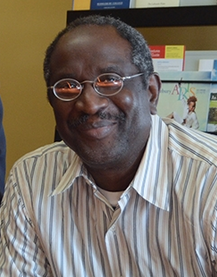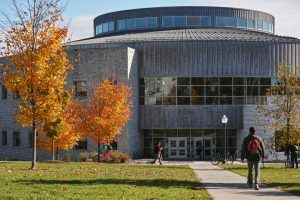 Nathaniel Nesmith, C3 Post-Doctoral Fellow in Theatre, wants his students to listen. To him, yes; but also to the playwrights whose works he teaches: African-American playwrights like Charles Gordone and Lorraine Hansberry, and white playwrights who wrote for black actors, like George Sklar and Eugene O’Neill. “Sometimes I feel like I’m lecturing too much. I can see students sort of wandering around. But then if you put on a two-minute video clip, it brings them right back into the fold.”
Nathaniel Nesmith, C3 Post-Doctoral Fellow in Theatre, wants his students to listen. To him, yes; but also to the playwrights whose works he teaches: African-American playwrights like Charles Gordone and Lorraine Hansberry, and white playwrights who wrote for black actors, like George Sklar and Eugene O’Neill. “Sometimes I feel like I’m lecturing too much. I can see students sort of wandering around. But then if you put on a two-minute video clip, it brings them right back into the fold.”
Here is an example of an interview with Lorraine Hansberry that can be found and streamed via the Internet Archive.
[archiveorg id=popuparchive-1863051 width=500 height=140]
Finding their voices
Nesmith specializes in 20th- and 21st-century drama, and focuses particularly on African-American theatre of the civil rights era. He faces some significant challenges in bringing the voices of these playwrights to his students: a marginalized population with limited access to the media has made for a small pool of audiovisual artifacts. Even when a recording was known to have been made, finding an extant copy of it now can be an enormous challenge. Many radio and television networks failed to preserve large portions of their output during this era, and of what was preserved, even less has been digitized and made readily available through the Internet. This has sometimes necessitated substantial direct research at archives and libraries around the country, trying to determine where a lone copy of an important radio interview or TV appearance might still be found. Dr. Nesmith worked with Middlebury librarians to search archives and collections around the country for media artifacts related to the playwrights he teaches.
“I think sometimes students now are so accustomed to getting things so quickly, it’s always just there for them.
Research means you have to spend some time and look for something. Sometimes you might know something exists, but it just hasn’t become available… particularly in terms of some of the African-American playwrights.”
But the hunt, when it’s successful, pays off in the form of student interest and engagement. “It stimulates the students… it engages them to go back and look for more in the text. Because if a playwright is talking specifically about something, then they want to go back and read that… it’s coming from the playwright’s mouth. Then the text seems
to have much more meaning.” Dr. Nesmith says that he’s often brought in short clips to show students, and found them asking for more once it was over. After listening to part of an interview with Lorraine Hansberry, he says his students wanted to keep going: “they go, ‘no no! Can we hear the rest of it? Can you keep playing it?’ And they were sitting there listening – because there was no visual, they were sitting there, listening – and I was really pleased that they wanted to hear it.” He can’t always indulge them, but he shows them where they can find the recording to listen on their own. “This is something I’m always trying to talk to students about: taking ownership of their time and the stuff that they make a commitment to. They’re investing their time in something they want to hear.”
The power of connection
For Dr. Nesmith, audiovisual materials are a bridge between the artist and the student, allowing the playwright to speak for themselves while also making the material more accessible to students who have a more visual understanding of the world.
“You realize that you’re dealing with history… it activates the mind a little differently; you certainly become more curious. When you have a playwright from the 50s talking about a play that was produced on Broadway in the 50s… that personalizes that text and it personalizes the historical perspective. So that personal interaction plays a major role, and I’ve discovered that it helps the students understand the play. And it helps not just the students — it helps me understand the play.”
An interview with Professor Nathaniel Nesmith, C3 Post-Doctoral Fellow in Theatre as shared by Amy Frazier, Film and Media Librarian

